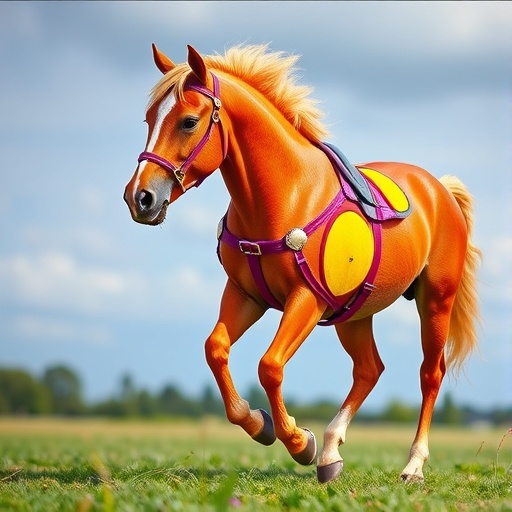In a groundbreaking study highlighted in BMC Genomics, a team of researchers led by Steensma, along with Ducro and Dibbits, has achieved a significant milestone in equine genetics. The focus of their investigation was to produce high-quality, haplotype-resolved reference genomes for two prominent horse breeds—the Dutch warmblood and the Friesian horse. These reference genomes serve as essential genetic blueprints for understanding breed-specific traits, enhancing breeding programs, and exploring genetic health issues within these horse populations.
The concept of haplotype-resolved genomes refers to the assembly of genetic material that accurately reflects the inherited combinations of alleles present on chromosomes. This level of detail is vital in the study of animal genomes, as it allows scientists to decipher complex traits and hereditary conditions that may be prevalent within specific breeds. The meticulous process undertaken by Steensma and his colleagues emphasizes the importance of capturing genetic diversity and the unique characteristics embodied by each breed.
The researchers employed a technique known as trio binning, a cutting-edge method in genomics that significantly enhances the quality of assembled genomes. Trio binning utilizes the genetic information of three related individuals—typically a mother, father, and offspring—to improve the accuracy and completeness of the genome assembly. This approach reveals not only the individual genetic sequences but also the lineage, which is crucial when elucidating genetic variations that may influence phenotype expressions in these equine breeds.
In the case of the Dutch warmblood horse, known for its agility and performance in competitive sports, the high-resolution genome assembly provides insights into the genetic underpinnings that contribute to these desirable traits. Similarly, the Friesian horse, renowned for its striking appearance and engaging temperament, also benefits from the revelations provided by their haplotype-resolved genome. The assembly efforts not only highlight genetic strengths but also pinpoint potential health vulnerabilities that breeders and owners need to be aware of.
A major advantage of having access to reference genomes is the facilitation of genome-wide association studies (GWAS). These studies enable researchers to correlate specific genetic variants with observable traits, paving the way for more informed breeding choices. Armed with this genetic knowledge, breeders can make strategic decisions that enhance characteristics like endurance, ability, and temperament while simultaneously reducing the risk of hereditary conditions.
Moreover, the impact of this research extends beyond the immediate implications for breeders and the equine industry. The methodologies developed and applied by the team can enrich the broader field of genomics, providing a model for similar endeavors in other livestock breeds or even non-domestic species. By advancing our understanding of genetics through the lens of these horse populations, this work creates synergistic opportunities across multiple domains of veterinary science and evolutionary biology.
Another noteworthy aspect is the ethical dimension surrounding genetic studies in livestock. As agricultural practices pivot toward more sustainable and informed breeding paradigms, understanding the genetic framework of animals like the Dutch warmblood and Friesian horse becomes vital. The ethical management of genetic information ensures that advancements lead to welfare improvements, not just enhancements in performance or aesthetic appeal.
While the study highlights a remarkable achievement, it also opens the door to questions regarding genetic modification and selective breeding. As we dive deeper into the genetic code, the potential to enhance or alter traits raises ethical discussions about the extent to which humans should manipulate animal genetics. The authors suggested that responsible stewardship of this genomic knowledge is paramount in advancing equine health and diversity without crossing ethical lines.
Furthermore, the collaborative nature of this research exemplifies the essence of modern scientific inquiry. In a field where interdisciplinary collaboration yields the richest results, the synthesis of insights from genetics, animal science, and computational biology has produced a robust foundation for future studies. The authors encourage further collaboration and sharing of genetic resources within the equine community to maintain the momentum of these insights and discoveries.
It is also important to note the role of technology in these advancements. High-throughput sequencing technologies have dramatically transformed the landscape of genomics. The ability to generate and analyze vast quantities of genetic data quickly allows researchers to undertake more ambitious projects and make discoveries that were previously unattainable. Steensma and his collaborators effectively harnessed these technologies, underscoring the dynamic relationship between innovation and discovery in the field of genomics.
As we look to the future, the implications of haplotype-resolved reference genomes are profound. These developments may play a crucial role in developing new therapeutic strategies for treating genetic diseases and enhancing the overall resilience of horse breeds. Understanding genetic diversity not only informs breeding strategies but also cultivates an appreciation for the remarkable biological heritage encapsulated within these animals.
Ultimately, the achievement of high-quality, haplotype-resolved genomes represents a significant leap forward in equine genetics. By illuminating the genetic architectures of the Dutch warmblood and Friesian horse, this research not only enriches our understanding of these iconic breeds but also informs a wealth of applications in veterinary medicine, conservation biology, and animal welfare. The contributions of Steensma and his team illustrate a vision for the future—a vision where enhanced genomic insights lead to healthier, more resilient horse populations that can thrive for generations to come.
The research concludes by calling for continued investment in genomic studies and technologies that support advancements in animal genetics. As we deepen our understanding of genetic frameworks and their implications, the implications for breeding practices, healthcare, and animal welfare will only continue to expand, ultimately enriching the bonds between humans and horses while fostering a commitment to informed stewardship of this incredible species.
Subject of Research: Haplotype-resolved reference genomes of the Dutch warmblood horse and Friesian horse.
Article Title: High-quality, haplotype-resolved reference genomes of the Dutch warmblood horse and Friesian horse using trio binning.
Article References:
Steensma, M.J., Ducro, B.J., Dibbits, B. et al. High-quality, haplotype-resolved reference genomes of the Dutch warmblood horse and Friesian horse using trio binning. BMC Genomics 26, 790 (2025). https://doi.org/10.1186/s12864-025-11985-0
Image Credits: AI Generated
DOI: 10.1186/s12864-025-11985-0
Keywords: Equine genetics, haplotype, reference genomes, Dutch warmblood, Friesian horse, trio binning, genomic insights, breeding strategies.




